Do English language learners, or English as a Second language students, learn better in sheltered programs? Should students receive some instruction in their native language – and if so, for how long in American public schools? What does current research show about teaching English to children who speak another language at home? What language programs seem to work best? Which seem to produce the weakest results?
Teaching Language Learners: What the Research Does – and Does Not – Say , a 19- page article published in American Educator attempts to summarize current studies, detail the differences between studies, and introduce a more nuanced language to a very passionate debate. Claude Goldenberg, the author, writes in a clear, accessible style – and explains various bureaucratic jargon as he goes reviews the material. This article, written for American public education teachers in a union publication, deserves a large readership from English teachers, ESL teachers, ELL administrators, bilingual advocates, and journalists writing about language politics.
The article made numerous important points, including:
- the rapid growth of English Language Learners (ELL) students in public schools;
- a solid majority of ELL students are actually born in the United States (Why????);
- smaller class sizes matter;
- some intensive instruction in the primary language, for an unknown duration, helps improve target language abilities in writing;
- a huge debate continues over best practices over duration and purpose of primary language instruction;
- teaching English language learners from countries with low literacy than teaching students who bring strong academic skills in their native language (shock, shock!)
- written skills of ELLs remain far below national standards, especially in high school;
- oral skills often lack written skills in ESL/ELL students;
- students have difficulty moving from intermediate oral skills to achieving actual fluency;
- standard tests seldom test oral skills, leading to speaking skills being somewhat neglected in ESL/ELL classrooms.
Personally, I found the first two pages a bit annoying with its predictable complaints implying the impossibility of a second grader, particularly an ELL second grader, learning everything that is expected by state mandates. Yet when Goldenberg moved beyond the predictable “union” frame “our impossible job” and actually starting summarizing two major meta-studies of ELL practices, he provided a balanced, informative, and level-headed article filled with illuminating details.
As an adult educator, I also thought the article made a powerful argument for a huge expansion and deepening of adult education programs if a solid majority of ELL students are actually born in the United States. Why should millions of children born and raised in the United States be unable to speak English? If you believe that speaking English helps students live in the United States and language and culture are related, then this article provides a litany of troubling details about the state of ELL instruction and public education programs in general.
I strongly urge ELL and ESL instructors to read the long, ambitious, and satisfying article. It may become a seminal work in MA programs for ESL teachers, especially for people working in American public schools. http://www.aft.org/pubs-reports/american_educator/issues/summer08/goldenberg.pdf
This sometimes ugly debate over language policy will probably heat up as McCain and Obama attempt to make distinctions in their immigration and education policies. Perhaps this article will help clarify the complicated issues that go beyond bumpersticker solutions.
Ask more. Know more. Share more.Create Compelling Conversations.
Visit www.CompellingConversations.com






No comments:
Post a Comment